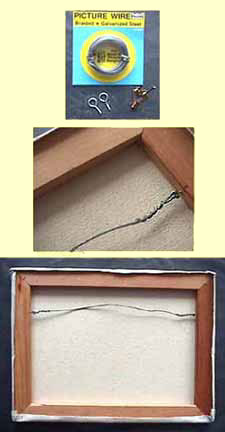


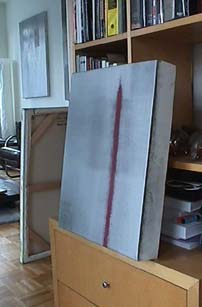
At a recent charity auction, I bought what I think is a good contemporary oil painting on canvas. Can I hang this picture unframed, or must I frame it? (It's leaning against the wall for the time being.)
If my painting needs to be framed, how do I go about selecting a frame that looks right? (I stopped by my local framers for inspiration and left hopelessly confused by the vast selection of options offered.)
What advice do you have when it comes to framing and hanging contemporary paintings?
Thanks,
Chris
How, or if, to frame a painting is a significant decision. A quality frame represents a substantial expense. A poorly chosen frame can ruin the appearance of the painting, while an appropriate one can make it shine. I'll try--if you'll forgive me a small jest--to frame the issues for you.
This unframed approach to exhibiting a painting means that the viewer focuses entirely on the artwork itself--both the good points and the flaws. Since the edges where the canvas wraps around the stretcher are usually studded with nails or staples and enhanced with paint dribbles, the unframed presentation is somewhat raw: It is like seeing the artwork in the artist's studio or in an informal show rather than in a gallery where a more finished presentation is the norm.
Pros: Wiring is inexpensive and easy. It allows the artwork to stand entirely alone.
Cons: Wiring offers no protection or reinforcement to the painting. If the stretcher is not sturdy enough, the weight of hanging may cause it to warp, sag or split. An unframed artwork will surely provoke your more fastidious friends to ask when you plan to frame it.
 Interesting exceptions: A few artists make paintings that are meant to hang unframed. In the photo of Todd Bellanca's studio (at the beginning of this article), we see a deep canvas with a clean crisp side that gives a sculptural look to the unframed piece. In the group of paintings shown at the right, another painter has made an effort to deal with the sides of his paintings by continuing the colors around the edges of each work.
Interesting exceptions: A few artists make paintings that are meant to hang unframed. In the photo of Todd Bellanca's studio (at the beginning of this article), we see a deep canvas with a clean crisp side that gives a sculptural look to the unframed piece. In the group of paintings shown at the right, another painter has made an effort to deal with the sides of his paintings by continuing the colors around the edges of each work.
Of course, most paintings do NOT have finished sides, so let's consider the possibilities for framing a typical painting to achieve a polished presentation.
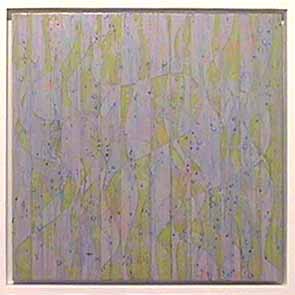

The more a frame draws attention to itself, the more it distances the viewer from the artwork and turns a painting into an object. These three examples at the right show a large Nancy Van Deren abstract painting first unframed, next with the addition of a handsome traditional gilt frame, then finally with a geometric silver one.

The fine, substantial carved frame gives the artwork a grand and formal appearance, and also brings out the warm gold and red tones in the painting. (The red bole ground peeking through the gold leaf amplifies this affect.)

For a completely different look, a crisp silvered wood molding reinforces the artwork's cool blues and greens and lends the painting a more architectural, modernist appearance.
In this instance, both framing choices present the painting appropriately (but differently), and this painting shows nicely unframed, too. Here the decision would be largely one of personal preference guided by the style of your home decor.
 The proportion of the frame to the painting can be adjusted to alter the appearance of the painting. This small, unframed painting by contemporary painter Lisa Dinhofer becomes a jewel-like object when fitted into its wide antique wooden frame with gold border. (The artist herself chose this antique frame to complement this piece; on occasion, she discovers an interesting frame, then fashions a canvas to suit it.)
The proportion of the frame to the painting can be adjusted to alter the appearance of the painting. This small, unframed painting by contemporary painter Lisa Dinhofer becomes a jewel-like object when fitted into its wide antique wooden frame with gold border. (The artist herself chose this antique frame to complement this piece; on occasion, she discovers an interesting frame, then fashions a canvas to suit it.)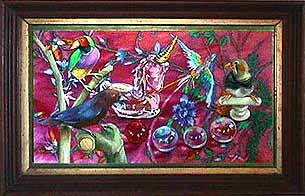 Providing a small painting is strong enough to hold its own visually, a large frame can be useful in reinforcing the importance of an artwork. In a purely practical sense, a wide frame can make a small work big enough to hold a larger expanse of wall. Remember, the greater the proportion of frame and its visual importance, the more a painting becomes transformed into an art object. (See this wide, intricate Stanford White frame for an example of a painting subsumed by gilded wood.)
Providing a small painting is strong enough to hold its own visually, a large frame can be useful in reinforcing the importance of an artwork. In a purely practical sense, a wide frame can make a small work big enough to hold a larger expanse of wall. Remember, the greater the proportion of frame and its visual importance, the more a painting becomes transformed into an art object. (See this wide, intricate Stanford White frame for an example of a painting subsumed by gilded wood.) In framing a medium or large size contemporary painting, less is more. A narrow (3/8 or 1/2 inch) floater molding can properly present even a very large artwork. Rule of Thumb: When in doubt select too thin over too thick. Surrounding a large expanse of canvas, a heavy molding tends to read as clunky.
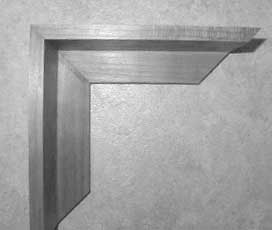
Rule of Thumb: Consider the frame as background. Unless an eye-catching frame completes the painting to perfection, try choosing instead a simple molding with a subdued finish. A low key frame lets your painting be the star.
Good luck with your project!
Yours,

